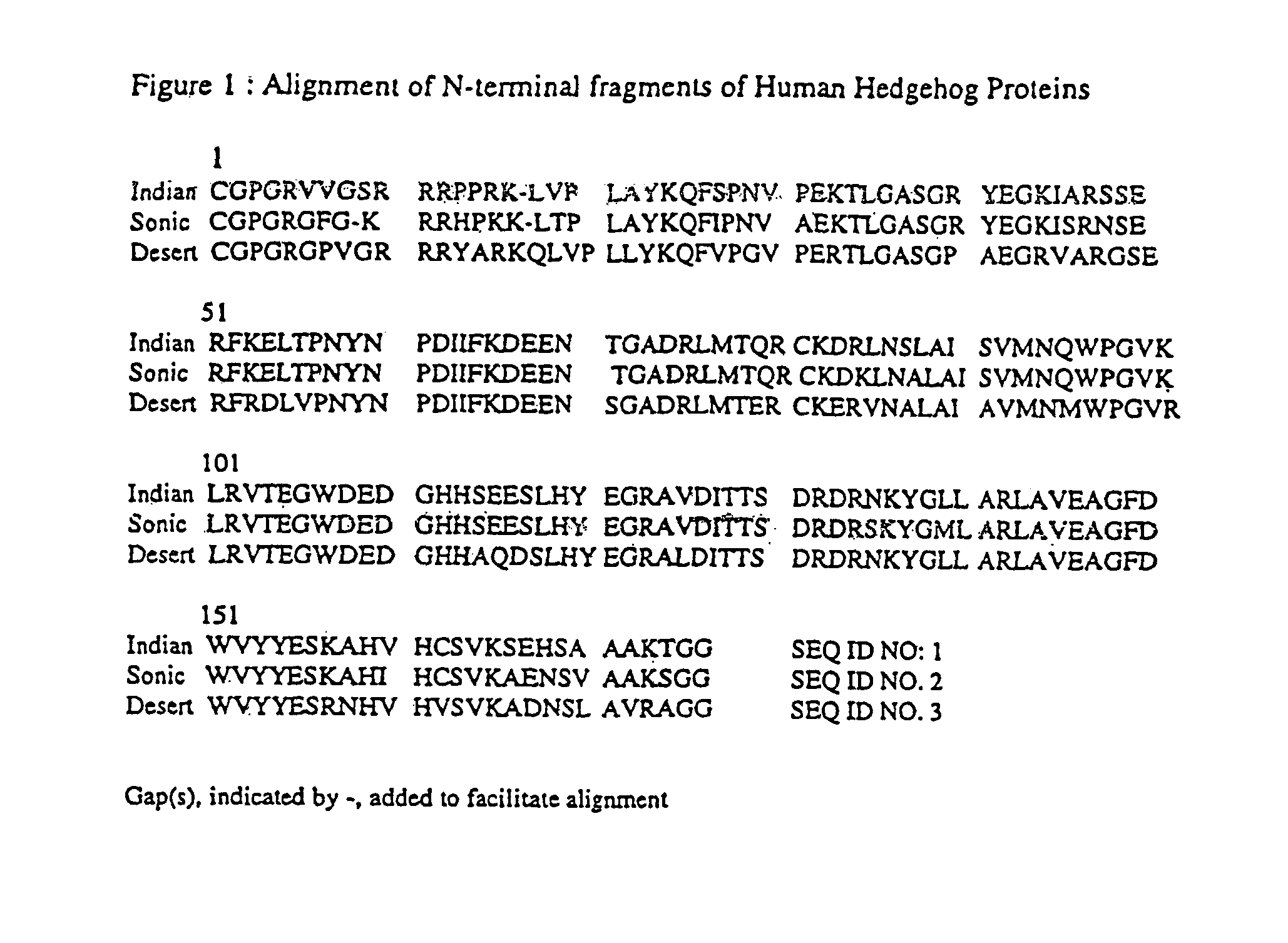Functional antagonists of hedgehog activity
a hedgehog activity and functional antagonist technology, applied in the field of hedgehog activity functional antagonists, can solve the problem of not allowing the induction of hedgehog-dependent signaling response in c3h10t1/2
- Summary
- Abstract
- Description
- Claims
- Application Information
AI Technical Summary
Benefits of technology
Problems solved by technology
Method used
Image
Examples
example 1
Production of Sonic Hedgehog in E. coli
A. Expression in E. coli
[0159]Human sonic hedgehog N-terminal domain (Shh) protein extending from the N-terminal cysteine of mature sonic hedgehog to amino acid residue 174 in the mature sequence (SEQ ID NO: 3) was subcloned into a pET11d expression vector as a six histidine-tagged fusion protein (histag-Shh) (see SEQ ID NO: 1) with an enterokinase cleavage site engineered into the construct immediately adjacent to the N-terminal cysteine of the mature Shh sequence. This plasmid (containing an ampicillin resistance gene) was transformed into E coli strain BL21 (DE3) plysS. In this system, IPTG induces expression fly of T7 RNA polymerase which in turn binds to a T7 promoter region on the transformed plasmid containing the gene of interest. If the target gene products are sufficiently toxic to E. coli, this basal level produced by the polymerase can be enough to prevent establishment of the plasmid. A second plasmid plysS (containing a chloramp...
example 2
Testing the Antagonists for Function
[0165]Various cell lines have been identified that are responsive to exogenously added hedgehog protein. These responses include the induction of ptc-1 and gli-1 mRNA (Takabatake et al, Febs. Lett. 410: 485-489 (1997)), induction of patched-1 expression (Nakamura et al., Biochem. Biophys. Res. Comm., 237: 465-469, (1997)), phosphorylation of fused (Threond et al., Proc. Nat. Acad. Sci., 93: 4224-4228 (1996), and for selected cell types of the chondrocyte / osteoclast lineage, induction of alkaline phosphatase activity. In the studies described here, we have used the C3H10T1 / 2 cell line as a reporter for hedgehog signaling. While mature sonic hedgehog was able to bind patched-1 and elicit signaling in the assays described below, a variety of hedgehog variants were identified that bound patched-1 with an affinity similar to mature protein but were inactive in selected functional readouts. These forms of hedgehog were not only inactive by themselves bu...
example 3
Detection of Antagonist from Shh Produced in Pichia pastoris
[0181]An “N-10” variant missing the first 10 amino acids of human Shh was generated by expression of a construct encoding the N-terminal fragment of mature Sonic hedgehog (SEQ ID NO: 3) in Pichia pastoris. All methods and growth media for Pichia pastoris are described in Invitrogen product manuals provided by the manufacturer.
[0182]Construction of pUB55-1: pUB55 contains the N-terminal domain of human Sonic Hedgehog (SEQ ID NO: 3) with the alpha factor PrePro region as the secretion signal. pUB55 was constructed in pCCM73, a derivative of pPIC9 (obtained from Invitrogen, San Diego, Calif.) with the Kanamycin gene (HincII-HincII fragment) of pUC4-K inserted at the Sph1 site of pPIC9. The human Sonic hedgehog coding sequence from EarI-Not1 was obtained from pEAG543 which has a stop codon and NotI site engineered following Gly197 in the coding sequence. Plasmid pCCM73 was cut with XhoI and NotI and was ligated with the EarI-N...
PUM
| Property | Measurement | Unit |
|---|---|---|
| temperature | aaaaa | aaaaa |
| pH | aaaaa | aaaaa |
| concentrations | aaaaa | aaaaa |
Abstract
Description
Claims
Application Information
 Login to View More
Login to View More - R&D
- Intellectual Property
- Life Sciences
- Materials
- Tech Scout
- Unparalleled Data Quality
- Higher Quality Content
- 60% Fewer Hallucinations
Browse by: Latest US Patents, China's latest patents, Technical Efficacy Thesaurus, Application Domain, Technology Topic, Popular Technical Reports.
© 2025 PatSnap. All rights reserved.Legal|Privacy policy|Modern Slavery Act Transparency Statement|Sitemap|About US| Contact US: help@patsnap.com



